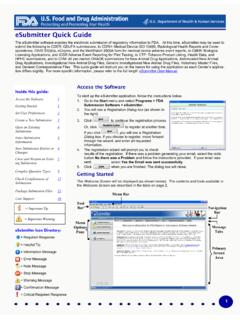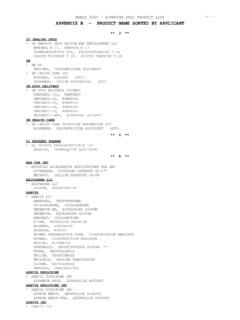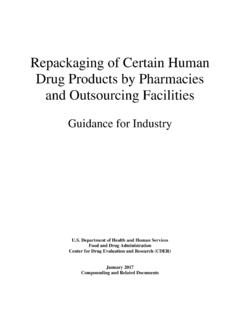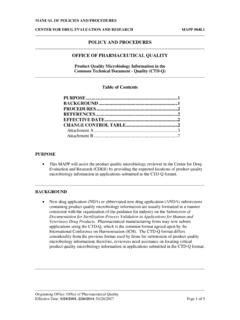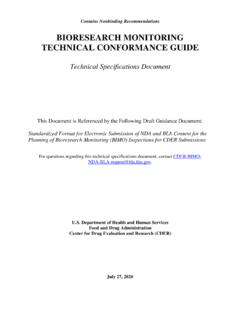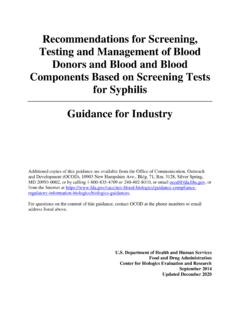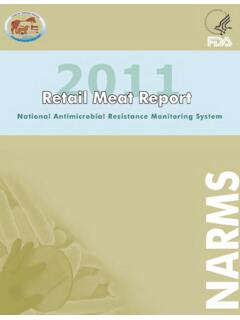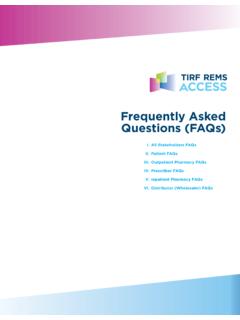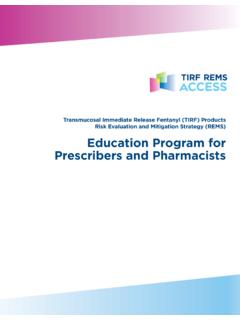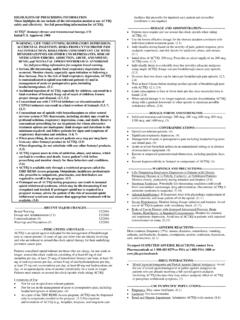Transcription of TRANSMUCOSAL IMMEDIATE RELEASE FENTANYL (TIRF) …
1 Initial REMS approval: 12/2011 Most recent modification: /2014 TRANSMUCOSAL IMMEDIATE RELEASE FENTANYL (TIRF) RISK EVALUATION AND MITIGATION STRATEGY (REMS) Page 1 of 16 Reference ID: 3677583 I. GOALS The goals of the TIRF REMS Access program are to mitigate the risk of misuse, abuse, addiction, overdose and serious complications due to medication errors by: 1. Prescribing and dispensing TIRF medicines only to appropriate patients, which includes use only in opioid-tolerant patients. 2. Preventing inappropriate conversion between TIRF medicines. 3. Preventing accidental exposure to children and others for whom it was not prescribed. 4. Educating prescribers, pharmacists, and patients on the potential for misuse, abuse, addiction, and overdose of TIRF medicines.
2 II. REMS ELEMENTS A. Medication Guide The product-specific TIRF Medication Guide will be dispensed with each TIRF prescription in accordance with 21 CFR The Medication Guides for TIRF medicines are part of the TIRF REMS Access program and will be available on the TIRF REMS Access website ( ). B. Elements to Assure Safe Use 1. Healthcare providers who prescribe TIRF medicines for outpatient use are specially certified. a. TIRF sponsors will ensure that healthcare providers who prescribe TIRF medicines for outpatient use are specially certified. b. To become certified to prescribe TIRF medicines, prescribers will be required to enroll in the TIRF REMS Access program. Prescribers must complete the following requirements to be enrolled: i. Review the TIRF REMS Access education materials (TIRF REMS Access Education Program), including the Full Prescribing Information (FPI) for each TIRF medicine, and successfully complete the Knowledge Assessment (Knowledge Assessment).
3 Ii. Complete and sign the Prescriber Enrollment Form. In signing the Prescriber Enrollment Form, each prescriber is required to acknowledge the following: a) I have reviewed the TIRF REMS Access Education Program, and I have completed the Knowledge Assessment. I understand the responsible use conditions for TIRF medicines and the risks and benefits of chronic opioid therapy. b) I understand that TIRF medicines can be abused and that this risk should be considered when prescribing or dispensing TIRF medicines in situations Page 2 of 16 Reference ID: 3677583 where I am concerned about an increased risk of misuse, abuse, or overdose, whether accidental or intentional.
4 C) I understand that TIRF medicines are indicated only for the management of breakthrough pain in patients with cancer, who are already receiving and who are tolerant to around-the-clock opioid therapy for their underlying persistent pain. d) I understand that TIRF medicines are contraindicated for use in opioid non-tolerant patients, and know that fatal overdose can occur at any dose. e) I understand that TIRF medicines must not be used to treat any contraindicated conditions described in the FPI, such as acute or postoperative pain, including headache/migraine. f) I understand that converting patients from one TIRF medicine to a different TIRF medicine must not be done on a microgram-per-microgram basis. I understand that TIRF medicines are not interchangeable with each other, regardless of route of administration, and that conversion may result in fatal overdose, unless conversion is done in accordance with labeled product-specific conversion recommendations (refer to the list of currently approved TIRF products located on the TIRF REMS Access website at ).
5 Note, a branded TIRF medicine and its specific generic product(s) are interchangeable. g) I understand that the initial starting dose for TIRF medicines for all patients is the lowest dose, unless individual product labels provide product-specific conversion recommendations, and I understand that patients must be titrated individually. h) I will provide a Medication Guide for the TIRF medicine that I intend to prescribe to my patient or their caregiver and review it with them. If I convert my patient to a different TIRF medicine, the Medication Guide for the new TIRF medicine will be provided to, and reviewed with, my patient or their caregiver. i) I will complete and sign a TIRF REMS Access Patient-Prescriber Agreement Form with each new patient, before writing the patient s first prescription for a TIRF medicine, and renew the agreement every two (2) years.
6 J) I will provide a completed, signed copy of the Patient-Prescriber Agreement Form to the patient and retain a copy for my records. I will also provide a completed, signed copy to the TIRF REMS Access program (through the TIRF REMS Access website or by fax) within ten (10) working days. k) At all follow-up visits, I agree to assess the patient for appropriateness of the dose of the TIRF medicine, and for signs of misuse and abuse. l) I understand that TIRF medicines are only available through the TIRF REMS Access program. I understand and agree to comply with the TIRF REMS Access program requirements for prescribers. Page 3 of 16 Reference ID: 3677583 m) I understand that I must re-enroll in the TIRF REMS Access program and successfully complete the enrollment requirements every two (2) years.
7 In signing the Patient-Prescriber Agreement Form, the prescriber documents the following: 1) I understand that TIRF medicines are indicated only for the management of breakthrough pain in patients with cancer, who are already receiving, and who are tolerant to, around the clock opioid therapy for their underlying persistent pain. 2) I understand that TIRF medicines are contraindicated for use in opioid non-tolerant patients, and know that fatal overdose can occur at any dose. 3) I understand that patients considered opioid-tolerant are those who are regularly taking at least: 60 mg oral morphine/day; 25 micrograms transdermal FENTANYL /hour; 30 mg oral oxycodone/day; 8 mg oral hydromorphone/day; 25 mg oral oxymorphone/day; or an equianalgesic dose of another opioid for one week or longer.
8 4) I have provided to, and reviewed with, my patient or their caregiver the Medication Guide for the TIRF medicine I intend to prescribe. 5) If I change my patient to a different TIRF medicine, I will provide the Medication Guide for the new TIRF medicine to my patient or my patient s caregiver, and I will review it with them. 6) I understand that if I change my patient to a different TIRF medicine, the initial dose of that TIRF medicine for all patients is the lowest dose, unless individual product labels provide product-specific conversion recommendations. 7) I have counseled my patient or their caregiver about the risks, benefits, and appropriate use of TIRF medicines including communication of the following safety messages: A. If you stop taking your around-the-clock pain medicine, you must stop taking your TIRF medicine.
9 B. NEVER share your TIRF medicine. C. Giving a TIRF medicine to someone for whom it has not been prescribed can result in a fatal overdose. D. TIRF medicines can be fatal to a child; used and unused dosage units must be safely stored out of the reach of children living in or likely to visit the home and disposed of in accordance with the specific disposal instructions detailed in Page 4 of 16 Reference ID: 3677583 the product s Medication Guide. I will ensure that the patient and/or caregiver understand that, in signing the Patient-Prescriber Agreement Form, they document the following: 1) My prescriber has given me a copy of the Medication Guide for the TIRF medicine I have been prescribed, and has reviewed it with me.
10 2) I understand that TIRF medicines should only be taken by patients who are regularly using another opioid, around-the-clock, for constant pain. If I am not taking around-the-clock opioid pain medicine, my prescriber and I have discussed the risks of only taking TIRF medicines. 3) I understand that if I stop taking another opioid pain medicine that I have been taking regularly, around-the-clock, for my constant pain, then I must also stop taking my TIRF medicine. 4) I understand how I should take this TIRF medicine, including how much I can take, and how often I can take it. If my prescriber prescribes a different TIRF medicine for me, I will ensure I understand how to take the new TIRF medicine. 5) I understand that any TIRF medicine can cause serious side effects, including life-threatening breathing problems which can lead to death, especially if I do not take my TIRF medicine exactly as my prescriber has directed me to take it.
